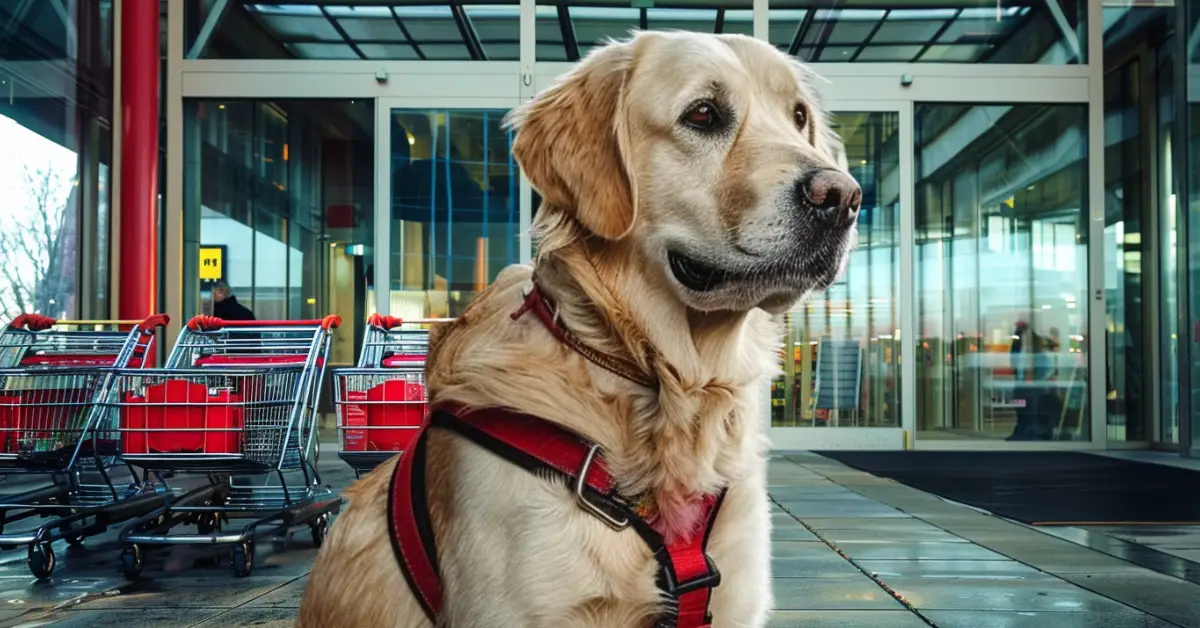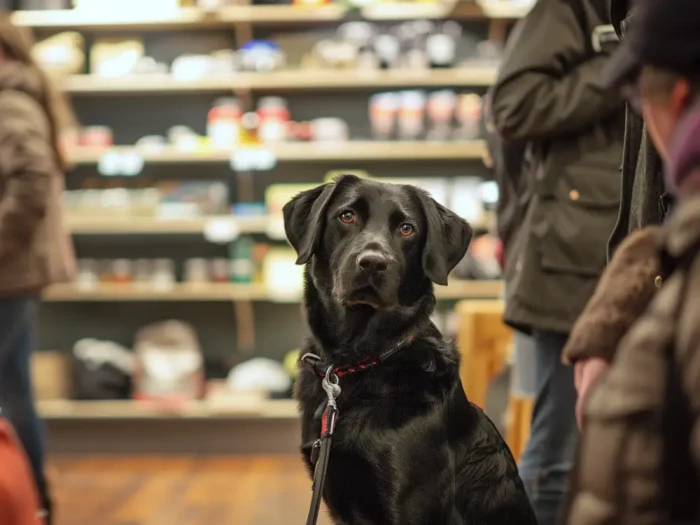When Stores Can Refuse Your Service Dog

According to the Americans with Disabilities Act (ADA), service dogs should be allowed into any store most of the time. A store owner can legally exclude a service dog if they are actively growling, snapping at, or frightening customers, or if the dog is obviously out of the control of its owner. Ordinary behaviors — panting, shedding, or even an isolated bark — should not be grounds for keeping a service dog out of a store.
For example, let’s say you bring your service dog into a store and walk peacefully through the aisles. A customer enters the store, says they are afraid of dogs, and asks the owner to tell you and your dog to leave. The store owner does not have the right to ask you and your dog to leave, though it would be a kind gesture to reassure the frightened customer and keep your dog as close to you as possible.
On the other hand, if your service dog is on a long leash and is barking and lunging at a child, that’s a different situation. Under those circumstances, the dog is not fully under your control — and it’s reasonable to interpret its behavior as threatening. In that case, the owner can ask you to take your dog out of the store.
In this article:
- Real-world scenarios
- ADA service dog rights in stores
- Preparing answers to allowed questions
- Preparing answers to expected questions
- What if the store owner won’t allow my service dog in?
- Additional ideas for making shopping easier
Real-World Scenarios
Here are some examples of situations that service dog owners frequently encounter in businesses where their service dog access rights are unfairly limited by staff:
The Shoe Store Visit
James has a mobility assistance service dog named Bailey who helps him maintain balance and retrieve dropped items. When entering a busy shoe store, the salesperson says, “We’re very crowded today, so you’ll need to sit in the corner with your dog.” James politely explains that under the ADA, he and Bailey have the right to be in other areas of the store like other customers. After a brief conversation about Bailey’s training, the salesperson allows them into the aisles.
The Department Store
Sarah’s service dog Max alerts her to oncoming diabetic episodes. While shopping for clothes, a store employee approaches and asks for documentation proving Max is a service dog. Sarah calmly explains that the ADA doesn’t require documentation and that Max is trained to detect blood sugar changes. The employee can only legally ask if Max is required for a disability and what tasks he performs. After this explanation, Sarah continues shopping without further issues.
The Grocery Store Violation
Michael’s PTSD service dog, Scout, helps him manage anxiety in public spaces. While in a grocery store, another shopper’s child runs toward Scout, trying to pet him. Scout, though startled, remains in a down-stay position beside Michael. A store manager witnessing this approaches Michael and says, “Your dog seems anxious around children. You’ll need to leave him outside.” Michael explains that Scout is a trained service dog protected by the ADA and that restricting where they can shop is a violation of his rights.
The Coffee Shop Challenge
Elena has an invisible disability and her psychiatric service dog, Luna, helps detect changes in her condition. When entering a busy coffee shop, the barista immediately says, “Health codes don’t allow dogs in food establishments.” Elena calmly responds that Luna is a service dog protected under the ADA, which supersedes local health codes for trained service animals. The barista, though initially confused, asks the two permitted questions and then apologizes for the misunderstanding. This scenario shows how conflicting regulations can create confusion for business owners.
ADA Service Dog Rights in Stores
For service dog handlers who visit a store, the ADA makes it plain that:
- A service dog can enter whether or not it is wearing any special vest or harness.
- A business owner can’t require a service dog owner to show any special documentation.
- A store can’t charge a service dog owner a special fee for cleaning up after their dog. This is true unless the dog causes damage beyond normal wear and tear–for example, scratching that causes damage to paint or knocking over and breaking products.
- A store can’t limit service dogs to a particular part of their premises. There are some exceptions where a service dog could be excluded for health or safety reasons, but in stores, that would be rare.
Preparing Answers to Allowed Questions
If you’re a service dog owner, you know that not every store owner understands or abides by the ADA. In some cases, their anxieties or lack of understanding can get between you and your ability to patronize the stores in your neighborhood. Fortunately, there are some easy ways to smooth the path.
Business owners and staff are very limited in what they’re actually allowed to ask you about your animal. They may ask:
- Is this dog a service animal that is required due to a disability?
- What type of work or task has the dog has been trained to do?
These two questions help business owners distinguish between pet owners who like shopping with their pets in tow and genuine service dog owners. But if you don’t have clear, easy-to-understand answers to these questions, business owners will be understandably confused.
Preparing Answers to Expected Questions
While business owners aren’t technically allowed to ask you many questions about your service dog, you can avert problems by answering frequently asked questions upfront. Here are some top questions that may concern reasonable merchants.
Is your dog friendly? Shop owners want to be sure your dog won’t growl or bite. First, you can explain that your dog is friendly when off duty, but while on duty — as he is right now — he is working and not available for petting or play. Second, you can reassure the shop owner that your dog is well-trained and won’t snap, growl, or bite.
Is your dog house-trained? No business owner wants (or should have to cope with) a dog that isn’t house-trained. The answer should always be yes!
How do you keep your dog under control? Anyone who has been around a poorly trained dog knows how hard it can be to keep some pets from sampling food, getting underfoot, jumping, or otherwise creating a bit of chaos. You may choose to reassure the shop owner by letting them know that your dog has had extensive training.
How does your dog help you? For many people, the terms “service dog” and “guide dog” are synonymous. This means it can be confusing to see an apparently sighted and non-disabled person with a service dog. While you don’t have to explain yourself beyond affirming your service dog helps with a disability and saying what task it performs, it can be helpful to describe how your dog ensures your safety and well-being.

What If the Store Owner Won’t Allow My Service Dog In?
The answer to this question depends on the situation.
If you are simply told “no dogs allowed,” and staff won’t listen to your explanations, ask to see the owner or manager. If a higher-level employee stands by their illegal behavior, you can let them know they’re in violation of ADA requirements and follow up with a report to the corporate office or with an ADA complaint.
If, on the other hand, you are denied access for a reason, the store owner may be in the right. For example, they may legally ask you to leave if your dog growls or snaps at someone, barks uncontrollably, gets in the way of patrons, or relieves itself on the floor. If any of these things happen, you will need to take your dog out of the store.
Additional Ideas for Making Shopping Easier
You have every right to simply walk into a store with your service dog. But to make things easier, try taking these proactive steps.
- If you plan to patronize the shop often, drop by at a convenient time to introduce yourself and your dog to the owner. Explain that you’ll be stopping by from time to time and answer any questions.
- If you have one, keep a copy of your doctor’s note or PSD letter handy. While you shouldn’t be asked for it, and it’s never necessary under the ADA, it can’t hurt to have it available.
- Put a Service Animal vest, ID card, or patch on your dog to clearly identify it. While not required, it is a quick and easy visual cue that your dog is not a pet.
- Use a handle or short tether to keep your dog close and reassure patrons and staff that your dog is under control.
- Avoid very crowded times so that your dog is less likely to encounter noise or have to move out of the way of patrons or curious children.
- Avoid shops that might trigger your dog’s anxiety. For most dogs, this includes stores that are very loud or chaotic, stores with very strong smells, and stores with very limited space.
- Be sure your dog has had a chance to relieve itself before entering the store.
Service dogs are legally welcome at any store in the United States, and they can make it much easier for you to shop. You must, however, ensure that your dog is properly trained and under control. To avoid any possible issues, be prepared to educate store staff and owners about your service dog, its work, and ADA rules.

About the Author: Lisa Jo Rudy, M.Div. has been writing on developmental disabilities and mental health since the early 2000s, when her son was diagnosed with autism. Lisa lives on Cape Cod, where she is the proud "mom" of two beautiful cats.
Latest Posts

Can you bring a service dog to a museum?
Yes, you can bring your service dog to the museum! All the major U.S. museums welcome guests with service animals in accordance with the Americans with Disabilities Act (ADA). There are some areas, however, that might be off-limits. Here’s what you should know if you plan to spend a day at the museum with your […]

Read More

How to Bring a Service Dog to Six Flags Magic Mountain
Service dogs are welcome at Six Flags Magic Mountain so long as they are, according to Six Flags, “trained to do work or perform tasks for people with disabilities.” Of course, your dog must be housebroken and remain on a leash or harness and under your control while at the park — and the park […]

Read More

How Much Should I Exercise My Service Dog?
Like any dog, a service dog needs exercise. While their work to support you involves a certain amount of physical activity, there’s a good chance it’s not enough to keep your dog healthy. The amount and type of exercise needed will depend on your dog’s breed and age. Fortunately, there is a wide range of […]

Read More